CHAPTER 9 REVIEW EXERCISES
CONCEPT CHECK EXERCISES
Determine each of the following as being either true or false.
To add two vectors by use of a diagram, place the tail of the second at the head of the first, keeping magnitudes and directions. The sum is the vector from the tail of the first to the head of the second.
For vector A, in standard position at angle of magnitude A, the magnitude of the x-component is
In adding vectors, the answer is the magnitude of the resultant.
The Law of Sines is used in solving a triangle for which two sides and the included angle are known.
The Law of Cosines is used in solving a triangle for which two sides and the angle opposite one of them are known.
The ambiguous case occurs when two sides of a triangle and one of their opposite angles are given.
PRACTICE AND APPLICATIONS
In Exercises 7–10, find the x- and y-components of the given vectors by use of the trigonometric functions.
In Exercises 11–14, vectors A and B are at right angles. Find the magnitude and direction (from A) of the resultant.
In Exercises 15–22, add the given vectors by using components.
In Exercises 23–40, solve the triangles with the given parts.
In Exercises 41–74, solve the given problems.
Three straight streets intersect each other such that two of the angles of intersection are and and the shortest distances between any two intersections is 540 m. What is the longest distance between any two intersections?
A triangular brace is designed such that sides meet at angles of and with the longest side being 5.00 cm longer than the shortest side. What is the perimeter of the brace?
An architect determines the two acute angles and one of the legs of a right triangular wall panel. Show that the area is
 If and what values of a will result in the ambiguous case with two triangle solutions? Explain.
If and what values of a will result in the ambiguous case with two triangle solutions? Explain.Find the horizontal and vertical components of the force shown in Fig. 9.80.
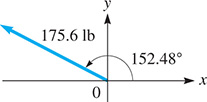
Fig. 9.80
Find the horizontal and vertical components of the velocity shown in Fig. 9.81.

Fig. 9.81
In a ballistics test, a bullet was fired into a block of wood with a velocity of 2200 ft/s and at an angle of with the surface of the block. What was the component of the velocity perpendicular to the surface?
A storm cloud is moving at 15 mi/h from the northwest. A television tower is south of east of the cloud. What is the component of the cloud’s velocity toward the tower?
Assuming the vectors in Fig. 9.82 are in equilibrium, find and

Fig. 9.82
A rocket is launched at an angle of with the horizontal and with a speed of 2500 ft/s. What are its horizontal and vertical components of velocity?
Three forces of 3200 lb, 1300 lb, and 2100 lb act on a bolt as shown in Fig. 9.83. Find the resultant force.

Fig. 9.83
In Fig. 9.84, F represents the total surface tension force around the circumference on the liquid in the capillary tube. The vertical component of F holds up the liquid in the tube above the liquid surface outside the tube. What is the vertical component of F?

Fig. 9.84
A helium-filled balloon rises vertically at 3.5 m/s as the wind carries it horizontally at 5.0 m/s. What is the resultant velocity of the balloon?
A shearing pin is designed to break and disengage gears before damage is done to a machine. In a test, a vertically upward force of 8250 lb and a 7520 lb at below the horizontal are applied to a shearing pin. What is the resultant force?
A magnetic force of 0.15 N is applied at an angle of above the horizontal on an iron bar. A second magnetic force of 0.20 N is applied from the opposite side at an angle of above the horizontal. What is the upward force on the bar?
A boat is tied to a dock at two points using ropes as shown in Fig. 9.85. The boat exerts a force of 325 N at an angle of from the line perpendicular to the dock. Make a free-body diagram, and then find the tensions and in the ropes perpendicular to and slanted from the dock, respectively.

Fig. 9.85
A water molecule consists of two hydrogen atoms and one oxygen atom. The distance from the nucleus of each hydrogen atom to the nucleus of the oxygen atom is 0.96 pm (see Section 1.4) and the bond angle (see Fig. 9.86) is How far is one hydrogen nucleus from the other?
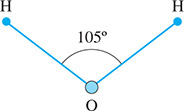
Fig. 9.86
A crate weighing 562 lb hangs from two ropes which are angled and from the vertical as shown in Fig. 9.87. Make a free-body diagram, and then find the tensions and in the left and right ropes, respectively.

Fig. 9.87
In Fig. 9.88, a damper mechanism in an air-conditioning system is shown. If when the spring is at its shortest and longest lengths, what are these lengths?

Fig. 9.88
A bullet is fired from the ground of a level field at an angle of above the horizontal. It travels in a straight line at 2200 ft/s for 0.20 s when it strikes a target. The sound of the strike is recorded 0.32 s later on the ground. If sound travels at 1130 ft/s, where is the recording device located?
In order to get around an obstruction, an oil pipeline is constructed in two straight sections, one 3.756 km long and the other 4.675 km long, with an angle of between the sections where they are joined. How much more pipeline was necessary due to the obstruction?
Three pipes of radii 2.50 cm, 3.25 cm, and 4.25 cm are welded together lengthwise. See Fig. 9.89. Find the angles between the center-to-center lines.
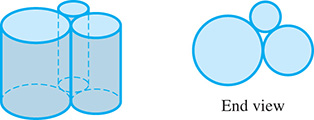
Fig. 9.89
Two satellites are being observed at the same observing station. One is 22,500 mi from the station, and the other is 18,700 mi away. The angle between their lines of observation is How far apart are the satellites?
A water skier is towed 65 m to the south of the starting point, and then is turned east of south for another 35 m. What is the skier’s displacement from the starting point?
A 116-cm wide TV screen is viewed at an angle such that the near end of the screen is 224 cm from the viewer, and the far end is 302 cm distant. What angle does the width of the screen subtend at the viewer’s eye? See Fig. 9.91.
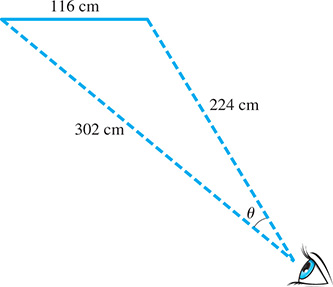
Fig. 9.91
The angle of depression of a fire noticed west of a fire tower is The angle of depression of a pond, also west of the tower, is If the fire and pond are at the same altitude, and the tower is 2.25 km from the pond on a direct line, how far is the fire from the pond?
A surveyor wishes to find the distance between two points between which there is a security-restricted area. The surveyor measures the distance from each of these points to a third point and finds them to be 226.73 m and 185.12 m. If the angle between the lines of sight from the third point to the other points is how far apart are the two points?
Atlanta is 290 mi and south of east from Nashville. The pilot of an airplane due north of Atlanta radios Nashville and finds the plane is on a line south of east from Nashville. How far is the plane from Nashville?
In going around a storm, a plane flies 125 mi south, then 140 mi at south of west, and finally 225 mi at north of west. What is the displacement of the plane from its original position?
One end of a 1450-ft bridge is sighted from a distance of 3250 ft. The angle between the lines of sight of the ends of the bridge is From these data, how far is the observer from the other end of the bridge?
A plane is traveling horizontally at 1250 ft/s. A missile is fired horizontally from it from the direction in which the plane is traveling. If the missile leaves the plane at 2040 ft/s, what is its velocity 10.0 s later if the vertical component is given by (in ft/s)?
A sailboat is headed due north, and its sail is set perpendicular to the wind, which is from the south of west. The component of the force of the wind in the direction of the heading is 480 N, and the component perpendicular to the heading (the drift component) is 650 N. What is the force exerted by the wind, and what is the direction of the wind? See Fig. 9.92.
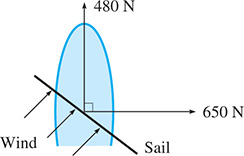
Fig. 9.92
Boston is 650 km and south of west from Halifax, Nova Scotia. Radio signals locate a ship east of south from Halifax and north of east from Boston. How far is the ship from each city?
 The resultant of three horizontal forces, 45 N, 35 N, and 25 N, that act on a bolt is zero. Write a paragraph or two explaining how to find the angles between the forces.
The resultant of three horizontal forces, 45 N, 35 N, and 25 N, that act on a bolt is zero. Write a paragraph or two explaining how to find the angles between the forces.

